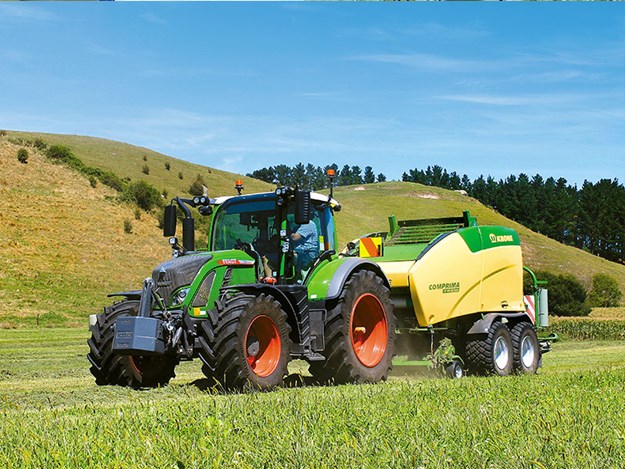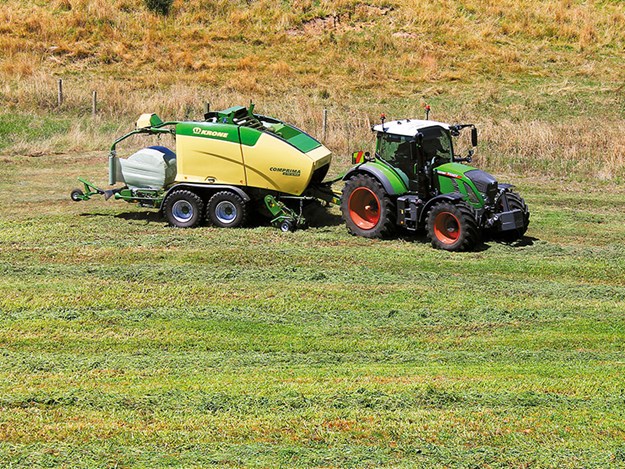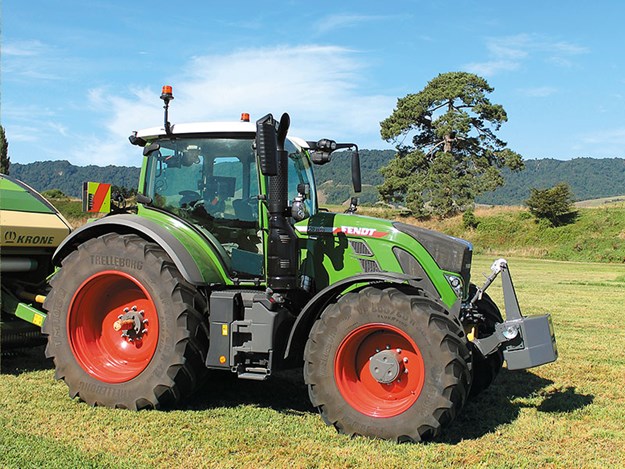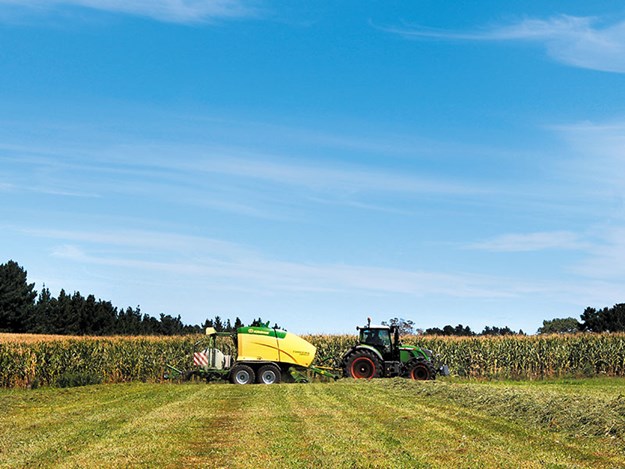Review: Fendt 720 Gen6 Profi Plus
It’s all about operator comfort with the new Fendt 720 Gen6 Profi Plus. Farm Trader test drives the new Gen6 model and approves of the upgrades.
Although the first of the Fendt Gen6 models have been in New Zealand for around 12 months now, they are still not common; partly due to the effects of a pandemic and the onflow of delays in getting parts for manufacturing and delivering new machines to the end user.
Supplied by Piako Tractors Morrinsville, my demo Fendt 720 was hooked up to a Krone Comprima CF 155XC Plus to do a few bales with, killing two birds with one stone. With an hour of road travel to kick things off, it was a good opportunity to check out ride quality and comfort, along with fuel efficiency.
 |
|
A versatile machine to have in the fleet – ideal for baling
|
Turns out that the hydraulic front axle with auto levelling, along with pneumatic suspension under the cab, makes for a good ride. Extra points considering the less than quality surface of the roading network through Waikato.
For me, however, the most impressive feature was the quietness in the cab (tested at 70.8db) and the fact that we could cruise along at 50km/hour while the engine sat on 1500rpm – this also helps at fill up time for the liquid gold we used to call diesel.
A new feature with the Gen6 is a two-function light setting control. Found on the same stalk as the shuttle, lights are now controlled through the touchscreen, where you could set up a field and road mode, which would make things easy when road carting silage at night, for example.
Also good to see is a full 360-degree LED light package as standard, rather than an extra on top of the price tag. The thing I like about Fendt tractors is the attention the brand pays to the smallest details. An example of this is the timed indicators, like your modern ute/car, which turn off after a set time. It all comes down to making life as easy as possible for the operator.
Another option available is auto steering lock for trailers and implements. The system locks the wheels in straight for road work and reversing, which just further simplifies things for the operator.
Engine
 |
|
Hydraulic, lights, and PTO at the front end
|
The well-proven 6.1 litre Deutz engine remains much the same and is used in Fendt models from the 714 to 724. Being mid-range, the 720 produces 201hp and 148kW. To achieve its Tier V rating, it makes use of most technology available with DOC, DPF, and SCR. A 38-litre AdBlue tank and 400-litre diesel tank should be more than enough to get you through a full day’s work.
At 200hp, the Fendt 720 is plenty big enough to handle most jobs, across cultivation, grass harvesting, and transport applications. As standard, it sits under 8000kg. Ballasted up with rear wheel weights and front weight block, you have the weight of a larger tractor in the nimble frame of the 7 Series. The most impressive thing for me about the 720 engine is the power it can produce at 1500rpm and how it operates at top road speed. I’d be interested to see how the fuel usage would go over a season in comparison to other equivalent tractor models, especially the way the fuel prices have been going lately. Fuel costs have become of enormous significance to agricultural contracting.
Transmission
 |
|
Quality LED work lights as standard
|
This is an area where Fendt has traditionally led, and most others have followed. The system uses split hydrostatic and mechanical drive, so, as speed increases, more power is directed to the mechanical, with the hydrostatic providing continuously variable speed. It’s easy to operate and ideal for start/stop jobs such as baling (as we were on test day).
In the construction of the Vario transmissions, there aren’t many moving parts to wear out, so it regularly does 6000 to 9000 hours before needing any attention.
Back to operation of the transmission and tractor. Fendt has stuck with what has worked previously – a two-range transmission: field and transport. A button is now incorporated into the new armrest/workstation rather than over on the right side of the cab as in the previous model.
There are still the same two drive mode options, either pedal mode or joystick, pushing forward to increase speed and back to decrease speed. There’s the option to set a max speed for each working range, as well as rpm to suit the task at hand (for PTO work for example). Then the engine and transmission work together to achieve optimal fuel efficiency, which Fendt are well known for.
Another feature I like is the push button on the back of the joystick, which changes direction when you push the joystick to the right, keeping one hand on the wheel without having to move the other away from controlling the functions of the tractor.
Engine braking is one area variable transmissions are not as strong. However, Fendt has a system that allows you to vary engine braking. Another thing I like is the exhaust brake, which knocks some of the speed off without actually needing brakes or relying on the transmission. In terms of implement brakes, there are, of course, hydraulic brake connections, being Profi Plus (also standard) with air brakes. These are becoming more common on larger trailers and implements here, like in Europe.
Styling
 |
|
Two quality German-manufactured machines
|
Externally, you probably wouldn’t notice any major changes in the 7 Series. The panorama cab still features a large, curved, one-piece front glass window, and five-pillar cab, with one door. Inside the cab, however, things have had a serious upgrade or modernisation, with what Fendt has called the FendtOne drivers’ workstation (not that there was anything wrong with the old cab layout).
However, once you get used to the new layout, it does make life easier. Everything is at your fingertips. I like the lighting system for the buttons: red when not selected, green when in use. Being the Profi Plus model, the demo tractor comes with most of the extras you would add (and then some) to a baseline model tractor. The cross-gate lever is still an option. However, the new 3L joystick gives the functionality to run an extra hydraulic function, particularly designed/useful for loader work for third service attachments such as bale clamps and grab buckets.
Cab
 |
|
Externally, little difference to the previous model
|
As mentioned, the layout of the previous 7 Series cab version was very good, although, this has been the focus for an upgrade with the Gen6. The all-new controller is ergonomic with consideration shown to long days in the field.
The large 12-inch armrest monitor can be split into as many as six quadrants. This should be enough to display most functions, including implement ISOBUS and GPS auto-steer. Even better, if you opt for the second roof screen, this keeps the cab free from the clutter of extra monitors and allows for optimal visibility, being able to recess it most of the way back into the roof (while still operating the lower portion for air conditioning or infotainment for example).
Depending on your preference, both screens can be operated by touchscreen or by using the push dial and hotkeys to navigate. A lot of brands are moving away from central dash displays, opting for small pillar displays. Fendt has added a 10-inch digital dash, displaying tractor function, speed, revs, fuel, etc. and configurable to display any other information drivers may choose.
Other details such as multiple USB ports and a phone holder mounted on the side of the main monitor (handy, given that a phone is just about as important as the tractor in
the contracting game these days) add to operator convenience.
Profi Plus has camera ports in the roof that can be wired from the machine directly to the tractor monitors or you can fit after-market options as this 720 has. Everything about the cab has been refined for maximum useability and minimum clutter, and I think Fendt has nailed it.
Summary
 |
|
Back when the maize was still standing
|
I must admit to having been a little sceptical about the need for an upgrade when I first learned of the pending release of the Gen6 Fendt tractors. I quite like familiarity and things staying the same and what was already on the market worked well. However, after only a short time in the driver’s seat of the new Fendt 720 Gen6 Profi Plus, the benefits of the new FendtOne drivers’ workstation are evident.
Everything is within easy reach, and it’s simple to navigate around the touchscreen and assign different functions to best suit the driver for ease of operation. The hardest part about driving the Fendt Gen6 720 Profi Plus? Taking it back at the end of the day. I’d be a happy tractor driver spending every day in there.
Fendt 720 Gen6 Profi Plus specifications
| Engine | Deutz, 6-cylinder, 6.1L, StageV, DPF, DOC, SCR |
| Engine rating | 201hp/148kW |
|
Diesel tank/ |
400L/38L |
| Transmission | Vario, 2 Range (Field/Road) |
| Max/min speed | 0.02–50km/hr @1500rpm |
| PTO | 4-speed 540/540E/1000/1000E Front PTO 1000 |
| Front suspension | Hydraulic, self-levelling/lockable |
| Hydraulic system | Load-sensing |
| Max hydraulic flow | 109L/min, 152L/min, 193L/min options |
| Steering pump | 115L/min |
| Remote valves | 5+2 |
| Rear linkage lift capacity | Max 10,360kg |
| Front linkage lift capacity | Max 4418kg |
| Cat | III |
Pluses
- Fuel-efficient engine and transmission
- New 10-inch digital dash
- One or two 12-inch touchscreen terminals
- All-new multi-function joystick and control layout with 3L joystick
- Heavy-duty, mid-size tractor with a range of horsepower options to suit a wide variety of tasks
Minuses
- Purchase price is up there
Find new and used farm machinery for sale in NZ
Keep up to date in the industry by signing up to Farm Trader's free newsletter or liking us on Facebook



.jpg)



.jpg)
.jpg)
-(1).jpg)

